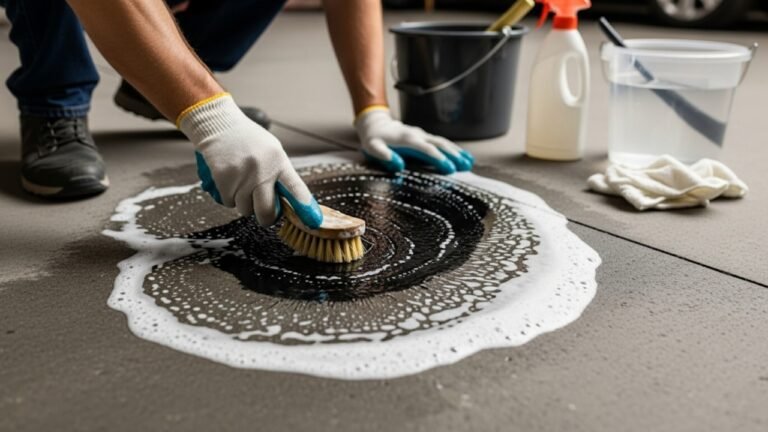Wrong Oil in Car: How to Fix It Without Damaging Your Engine

We’ve all had those heart-stopping moments. You’re doing a quick oil change or topping off the oil, and then suddenly—it hits you. Did you just use the wrong oil in your car? That sinking feeling in your stomach is real, and you’re not alone. Whether it was using 5W-30 instead of 0W-20, or accidentally grabbing conventional instead of synthetic, mistakes happen.
But here’s the good news: putting the wrong oil in car and how to fix that issue isn’t as terrifying as it sounds—if you act quickly and follow the right steps. I’ve been there. One winter morning, I topped off my car with the only oil I had on hand—an old bottle of 10W-40. It was thick, sluggish, and totally wrong for my vehicle. What happened next was a lesson in quick fixes, mechanic advice, and some good old-fashioned trial and error.
In this guide, we’ll walk you through how to fix wrong oil in car, what symptoms to watch for, and how to prevent future oil mix-ups. Think of this as a casual chat between friends—just one of us happened to panic-Google “wrong oil in car how to fix” last weekend.
How Engine Oil Works and Why the Right Type Matters
Let’s make this super simple: your car’s engine oil is like blood in the human body. It lubricates all the moving parts, reduces heat, and helps keep things clean inside your engine. Now imagine trying to pump molasses through your veins. That’s what happens when you use the wrong viscosity or type of oil.
Here’s a quick breakdown:
| Oil Type | Best For | Issues if Misused |
|---|---|---|
| 0W-20 | Modern engines, cold weather | Too thin for older engines |
| 5W-30 | Balanced option | Can strain high-performance engines |
| 10W-40 | Older engines | Too thick for newer cars |
| Synthetic Oil | High performance, long life | May damage seals in older cars |
| Conventional Oil | Older engines, budget option | Breaks down faster in heat |
Using the wrong oil in car affects oil pressure, engine temperature, and even long-term wear. While one mistake won’t ruin your car, repeated errors—or leaving the wrong oil in too long—absolutely can. That’s why knowing how to fix it fast matters.
First Signs You May Have Used the Wrong Oil
Your car isn’t going to scream at you right away, but it will whisper if something’s wrong. Here’s what I noticed the morning after my little oil slip-up:
-
Engine felt rough on startup.
-
Acceleration was sluggish.
-
Slight ticking sound from the engine bay.
-
Check engine light came on briefly.
If you’re asking, “wrong oil in car how to fix?”, step one is noticing these red flags early. These signs usually mean the oil is too thick or too thin to circulate properly. It’s either not reaching small engine parts or isn’t building enough pressure.
Other symptoms may include:
-
Lower fuel economy
-
Overheating engine
-
Excess exhaust smoke
-
Poor idle or engine knocking
Don’t panic. These aren’t signs of a ruined engine—yet. They’re just your car’s way of saying, “Hey, something’s off. Help me out.”
Step-by-Step: How to Fix Wrong Oil in Car (Without Calling a Tow Truck)
So, you’ve used the wrong oil. Here’s the good news: You can fix it, often without visiting a mechanic. Below is a proven 6-step process based on what’s worked for me and thousands of other DIY drivers:
1. Don’t Drive Any Further
If you just realized your mistake while still parked or after a very short drive, turn the engine off immediately. Every extra mile spreads the wrong oil deeper into your engine.
2. Let the Engine Cool Down
If the engine is hot, wait at least 30 minutes before touching anything. Hot oil can burn you badly. Be patient.
3. Drain the Oil Completely
Use a wrench to remove the drain plug and empty all the oil into a container. This is the most important part. Make sure the engine is on level ground, and drain it until the last drop.
4. Replace the Oil Filter
The oil filter now contains traces of the wrong oil, and keeping it would only contaminate the new oil. Always replace it.
5. Refill with the Correct Oil
Check your owner’s manual or oil cap. Refill with the recommended viscosity and type—whether it’s synthetic, conventional, or blend. Don’t mix two oils unless it’s an emergency.
6. Run the Engine and Check for Symptoms
Start your engine and let it idle for 5-10 minutes. Listen for odd sounds and check for smoke or warning lights. If all is well, you’ve fixed the problem.
Pro Tip: After a week, do another oil change just to flush out any lingering residue from the incorrect oil.
What Happens If You Keep the Wrong Oil in Your Car?
Sometimes people just cross their fingers and hope for the best. But leaving the wrong oil in car can cause serious engine damage over time. Here’s what could happen:
-
Premature Engine Wear: Parts that need lubrication might be left dry or poorly protected.
-
Increased Friction: Thick oil can’t flow easily, while thin oil can’t maintain pressure.
-
Gunk and Sludge Build-Up: Especially if the oil breaks down too fast under heat.
-
Overheating: Lack of proper lubrication increases internal temperature.
In short, it’s like wearing flip-flops on a snowy mountain hike—not the best idea. Always fix the issue quickly before it becomes a bigger headache.
Can Mixing Oil Types Ever Be Okay?
Let’s clear the air: mixing oils is not ideal, but it’s not catastrophic if it’s temporary. For instance, if you added synthetic oil to conventional, or mixed 5W-30 with 10W-40 in a pinch, your car won’t explode.
But don’t let it sit like that for months. Different oil types have different additives, and they can cancel each other out or reduce oil effectiveness.
So yes, it’s okay for emergency top-ups, but you should drain and refill with the correct oil as soon as possible.
How to Protect Your Engine After an Oil Mix-Up
You’ve fixed the immediate issue. Now let’s talk about long-term care. Just like you wouldn’t walk off a twisted ankle without rehab, your engine needs a little TLC after running on the wrong oil—even briefly.
Here’s how to give your engine a fresh start:
-
Run High-Quality Oil for a While
Choose a premium synthetic oil that meets or exceeds your car’s recommended specs. Quality oil has better detergents that help clean leftover gunk. -
Use an Engine Cleaner (Optional)
Some drivers add a pre-oil-change flush treatment to help remove any lingering sludge. It’s not essential, but it can give your engine a deeper clean. -
Shorten Your Next Oil Change Interval
If your car normally goes 5,000 miles between changes, do the next one at 3,000 miles instead. This helps flush out any trace contaminants from the prior mishap. -
Keep an Eye on Performance
Pay close attention to how your car sounds and feels. If it starts idling rough, showing warning lights, or consuming oil too quickly, get it checked out. -
Document the Incident
Keep a note in your service log about the wrong oil episode and when you fixed it. If anything happens under warranty, you’ll want to show you acted responsibly.
It’s all about balance—just like your body needs time to recover from stress, so does your engine. Be patient and proactive.
Oil Change Tips: Avoiding the Same Mistake Again
After my own oil blunder, I started treating oil changes like cooking a favorite recipe. I didn’t just wing it anymore—I prepped, measured, and double-checked. Here’s what you can do to prevent another “wrong oil in car how to fix” situation:
-
Label Your Oil Bottles: Use a permanent marker to write the oil type and viscosity clearly on each bottle.
-
Use the Owner’s Manual: Don’t rely on memory. Check the manual every time.
-
Keep Oil Receipts: This helps track what you’ve used and avoids reusing wrong oils by accident.
-
Buy From Reliable Sources: Gas stations and sketchy discount stores often carry outdated or mislabeled products.
-
Stick to One Oil Type: Switching back and forth between synthetic and conventional can get confusing. Choose one that works best for your car and stay consistent.
-
Set Reminders: Use your phone to schedule oil change dates and types, just like a doctor’s appointment.
Cultural Oil Myths That Can Lead to Mistakes
Let’s get real for a moment. If you’re from a community like mine—where car tips come from uncles, neighbors, or the tea shop guy—then you’ve heard some wild advice about oil.
Here are some common myths that could lead to using the wrong oil:
-
“Thicker oil is always better.”
No, thicker oil can starve modern engines of lubrication—especially in cold starts. -
“Synthetic oil causes leaks.”
Synthetic doesn’t cause leaks; it just reveals existing ones due to better flow. -
“You can mix any oil if it’s just once.”
While it won’t instantly kill your engine, even one-time mixing should be corrected ASAP. -
“Diesel oil works better in petrol cars.”
Diesel oil has additives that can harm spark plugs and emissions systems in gas engines. -
“You don’t need to change the filter every time.”
A dirty filter can contaminate clean oil within minutes. Always change it.
Respect your elders—but also double-check with science and manufacturer recommendations!
FAQs About Wrong Oil in Car and How to Fix
1. What happens if I drive with the wrong oil?
Driving with the wrong oil can cause low pressure, overheating, or poor engine lubrication. Long-term use may lead to engine damage or even failure.
2. Can wrong oil cause the check engine light?
Yes. Some modern cars detect oil pressure or flow problems and may trigger the check engine light or an oil warning light.
3. Is mixing synthetic and conventional oil okay?
It’s not ideal but won’t harm your engine if it’s just once. Still, it’s best to drain and replace it soon after.
4. How much does it cost to fix the wrong oil mistake?
If you DIY, the cost is roughly $40–$80. A mechanic might charge $100–$200 for a flush and new oil/filter.
5. Can thick oil damage my engine?
Yes. Thick oil may not flow fast enough to lubricate vital components, especially during cold starts or in modern engines with tight tolerances.
6. Should I use an engine flush after wrong oil use?
Not required, but it can help remove contaminants, especially if the wrong oil was used for a while.
7. How long is too long with wrong oil?
Driving more than a few hundred miles with the wrong oil increases the risk of damage. Fix it ASAP.
8. Can I just top up the correct oil without draining the old?
Topping off may help temporarily but won’t solve compatibility issues. Always drain and refill when oil types don’t match.
Final Thoughts: Don’t Panic, Just Act
If you’ve ever felt like screaming into your steering wheel after realizing you used the wrong oil, trust me—you’re not alone. It’s like adding salt instead of sugar to your tea. It tastes wrong, but you can fix it if you catch it early.
The most important thing is not to ignore it. Your car won’t magically “adjust” to the oil—it’s not that forgiving. But with some calm, a bit of know-how, and about 45 minutes of your time, you can reverse the mistake before any real damage happens.
And hey—next time you walk into an auto shop, you’ll be the person giving advice, not Googling “wrong oil in car how to fix” in a panic.






